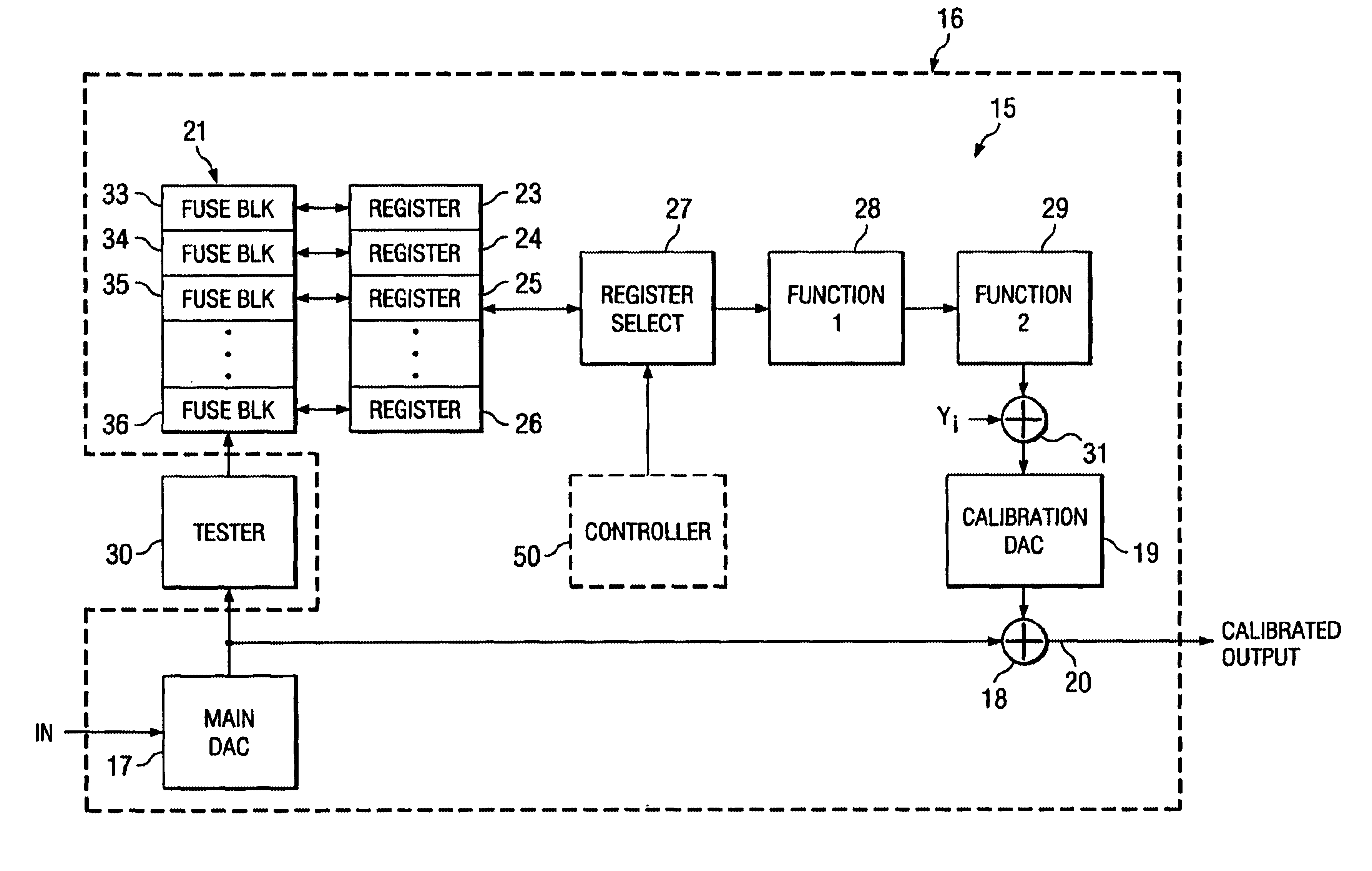In light of the above, therefore, it is an object of the invention to provide an improved digital-to-analog converter that has improved
linearity and methods for constructing and operating same.
The present invention presents a digital-to-analog converter (DAC) with digital calibration to improve the overall
integral nonlinearity (INL) performance. In one embodiment, the architecture includes of a 10 bit
resistor string that
decodes the 10 most significant bits (MSBs) and a 6 bit interpolating
amplifier, which is used to decode the 6 least significant bits (LSBs). The DAC has digital calibration to improve INL characteristics. The
resistor string architecture alone has good
differential nonlinearity (DNL) characteristics, but suffers from high INL errors. Thus,
transfer function errors of the DAC are computed during final test at specific points. The errors at these points are coded into permanent on-
chip memory as control points. These control points then drive digital circuits that implement the math for piece-wise linear calibration waveform generation. A calibration DAC then sums the inverse of the error
voltage to correct for the offset
gain and
linearity errors.
With reference now back to FIG. 1, a graph is shown of the actual integral nonlinearities (INL) of the main DAC 17 vs. input
code word values. The graph of FIG. 1 compares a curve 10 of typical INL values of the
signal output of an actual DAC constructed in accordance with a preferred embodiment of the invention with a piecewise
linear approximation thereof 12. The piecewise
linear approximation curve 12 is developed from the uncalibrated DAC having the INL profile 10, which follows the waveform shown, by selecting a set of codes, for example, conveniently based upon the waveshape of the measured, or actual, INL. Each code location X, and the corresponding INL value, Y, at selected codes constitutes a "
control point", C.sub.i (Xi,Yi),C.sub.i+1 (X.sub.i+1,Y.sub.i+1) . . . C.sub.i+n (X.sub.i+n,Y.sub.i+n) 14, 14.sup.I . . . 14.sup.VI. The piecewise
linear approximation 12 of the INL curve 10 then allows linear interpolation between each adjacent pairs of the control points 14 and 14.sup.I, . . . 14.sup.V and 14.sup.VI to approximate INL for any input code, for example, at point 14.sup.k corresponding to codeword C.sub.k. At this juncture, it should be noted that although the piecewise linear curves are shown as each being a single, continuous linear waveform, the waveforms may follow other piecewise linear curves as well. For example, the piecewise linear curves may be saw-tooth or other convenient waveform. Moreover, although presently piecewise linear INL approximations are preferred,
linearity error can also be approximated and removed by implementing higher order polynomials, such as B-Splines, in the digital domain, as shrinking process geometries make this feasible. These approximation curves then can be used to construct and operate a calibrated DAC circuit, such as the calibrated DAC circuit of FIG. 5, using the steps shown in FIG. 3. The method and apparatus of this invention makes INL calibration possible through interpolation, without actually storing the INL values for most of the DAC inputs
It should be noted that as an option, either the difference in the
control point values may be stored in the fuses, or, alternatively, the actual
control point value may be stored. Storing the difference in control point values requires eight fuses for each control point (since the difference can range from 128 to 128 LSBs) amounting to a total of 72 fuses. This eliminates the need for a subtraction circuit. However, as can be seen from Equation 1 above, the actual value of each control point is required to evaluate the final expression. Thus, it may be desirable in some cases to store the actual control points rather than the difference.
In operation, to determine to identify which is the correct pair of control points between which the arbitrary input code lies, the first few MSBs of the input code and the control points may be compared. The arithmetic blocks 28 and 29 then perform division and multiplication functions, as follows. The calculation of slope of the applicable piecewise linear segment in Equation 1 requires division by the difference in the input code values of two adjacent control points. To make this division operation simple, the control points can conveniently be spaced uniformly with a known X axis spacing of "k times a power of 2". The difference in the x-axis of two adjacent control points is then a power of two, so the division will be a simple arithmetic
right shift. The
right shift operation can be achieved by just connecting the data buses in an appropriate manner, and thus the requirement of the
shift register can be totally eliminated.
 Login to View More
Login to View More  Login to View More
Login to View More 


